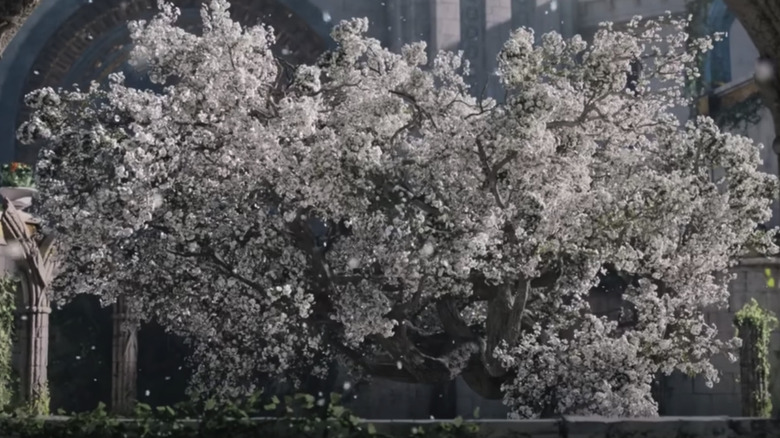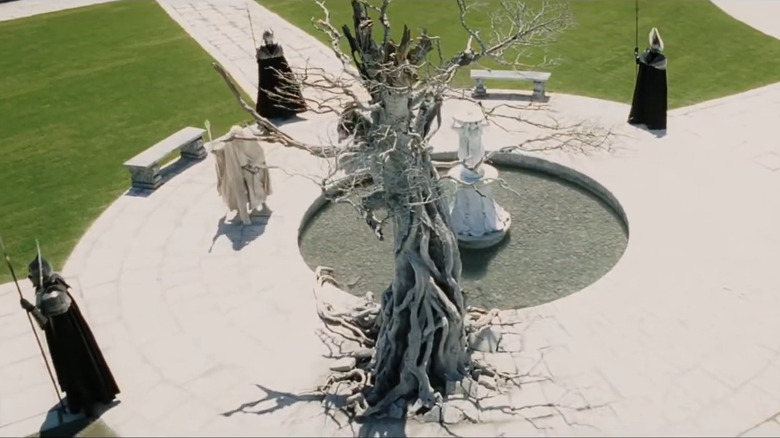The Connection Between The Rings Of Power's Númenor And The Lord Of The Rings' Gondor Explained
Contains Spoiler's for "The Lord of the Rings: The Rings of Power" Episode 3
Gondor is the most glorious kingdom of men in "The Lord of the Rings." It's responsible for building the colossal statues of the Argonath, Saruman's impenetrable tower of Orthanc, Minas Tirith, and many other impressive Middle-earth landmarks. And yet, Gondor's architectural and cultural portfolios pale when compared to its ancestor's accomplishments on the mighty island nation of Númenor. The third episode of Amazon Prime's "The Lord of the Rings: The Rings of Power" series finally unveils Númenor in all of its resplendent glory, and it doesn't disappoint. The majesty, splendor, opulence, and sheer size of Númenor are a little dizzying to take in.
While Númenor is, in many ways, the ultimate manifestation of Human achievement on Middle-earth, Gondor does manage to capture a lot of its most important elements later on. The architecture is very similar. Both kingdoms' mannerisms and cultures reflect one another. The royal lines of both kingdoms are connected, too.
Most of these affiliations are fairly vague, but there's one very visible, tangible item from both Gondor and Númenor that visually ties the two kingdoms together more than anything else: both have White Trees that play a key part in their national identity and iconography. This similarity in Middle-earth branding isn't a coincidence, either. Why? Because the two trees are literally related.
Nimloth in Númenor
Tolkien was a nut for family trees and complex lineages — the guy literally traced a direct line from Elros, the first king of Númenor, directly to Aragorn, who lives over six thousand years later. Characters like Elrond and Galadriel also have intricately detailed and complex familial connections. And yes, the author also applied this emphasis on lineage to his trees, too — and we're not referencing Ents here (in fact, they're surprisingly underdeveloped as far as family structure goes). We're talking about the White Tree of Númenor, a tree called Nimloth.
"The Silmarillion" describes the genesis of Nimloth in typically name-heavy Tolkienian language, saying that Elves would visit Númenor from Valinor away in the West early in the island's history, and they would bring gifts. "And a seedling they brought of Celeborn, the White Tree that grew in the midst of Eressëa, and that was in its turn a seedling of Galathilion the Tree of Túna, the image of Telperion that Yavanna gave to the Eldar in the Blessed Realm." Without going into too much detail, this description traces the ancestry of that White Tree directly back to the silvery glowing tree that provides light for Valinor (and which Morgoth destroys at the beginning of "The Rings of Power" prologue). In other words, it has a pedigree that even Treebeard would be jealous of.
Eventually, Nimloth's existence is threatened through a series of events that we won't specify to avoid too many spoilers. Before anything bad happens, though, none other than our boy Isildur sneaks onto the palace grounds and steals one of its fruits, saving the hallowed arboreal family tree in the process.
The White Tree(s) of Gondor
Through a series of events (again, minimal spoilers here), Isildur ends up on the mainland of Middle-earth, where he and his brother establish Gondor. But if you're thinking, "Oh, and then he plants the seedling of Nimloth, cool." Think again.
Isildur initially plants his new White Tree in his own fortress of Minal Ithil. If you don't recognize that name, that's because by the time of "The Lord of the Rings," the place goes by the cognomen Minas Morgul and its the headquarters of the Nazgûl (that's the creepy fortress with the glowing green light from Peter Jackson's movies).
When Isildur gets kicked out of that stronghold, though, he takes a sapling of the tree and plants it in his brother's fortress, a place that eventually is called Minas Tirith. Ah yes, we've finally gotten the White Tree of Gondor to its rightful place — but it still isn't the same tree. This first tree dies over 1600 years later during a plague, and another sapling of the tree is planted. This eventually dies, too, but it's finally the dead tree that we see in "The Return of the King" — which is replaced by yet another sapling after Aragorn is crowned.
It's a complicated and dramatic story, which is appropriate for Tolkien, who loved both trees and backstories. It's also a cool through-line that directly connects both Númenor and Gondor as well as "The Rings of Power" and "The Lord of the Rings" storylines.


